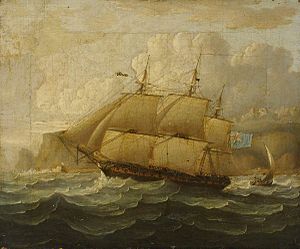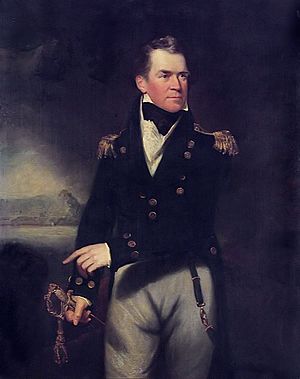HMS Leander (1813) facts for kids

HMS Leander at Sea, Thomas Buttersworth
|
|
Quick facts for kids History |
|
|---|---|
| Name | HMS Leander |
| Ordered | 6 May 1813 |
| Builder | Wigram, Wells & Green, Blackwall |
| Laid down | June 1813 |
| Launched | 10 November 1813 |
| Completed | By 18 February 1814 |
| Fate | Broken up in March 1830 |
| General characteristics | |
| Class and type | 50-gun fourth rate |
| Tons burthen | 1,57210⁄94 bm |
| Length |
|
| Beam | 45 ft 1+1⁄2 in (13.754 m) |
| Depth of hold | 14 ft 4 in (4.37 m) |
| Sail plan | Full-rigged ship |
| Crew | 450 |
| Armament |
|
HMS Leander was a powerful warship of the Royal Navy with 50 guns. She was a special kind of frigate called a "spar-decked" frigate. This meant she had guns on her top deck, unlike regular frigates that had an open space in the middle. Leander served during the Napoleonic Wars, the War of 1812, and the Second Barbary War.
Leander and a similar ship, HMS Newcastle, were built to be very large and strong. They were created because the British Navy needed ships that could stand up to the big American frigates during the War of 1812. Leander was a successful ship. She sailed with groups of other ships to hunt American frigates, but the war ended before they could catch them. Later, Leander was changed so she could be a special ship for admirals (high-ranking naval officers) in other countries. She fought in a big battle called the Bombardment of Algiers in 1816. She fired over 3,000 cannonballs and many of her crew were hurt. After this, she served as an admiral's ship in North America and then in the East Indies. She returned to Britain in 1822 and was taken apart in 1830.
Building a Powerful Warship
HMS Leander was ordered on May 6, 1813. She was built by a company called Wigram, Wells & Green in Blackwall. Her construction started in June 1813. To get her ready for service quickly, she was built from pitch pine, a type of softwood. She was launched on November 10, 1813, which was less than five months after building began! She was then moved to Woolwich Dockyard and finished by February 18, 1814.
These large 50-gun ships, like Leander, were built to fight against the strong American frigates, such as the USS Constitution. A "spar-decked" frigate meant she had a continuous row of cannons on her highest deck. Regular frigates usually had an open space in the middle of their top deck where no guns were placed. Another similar ship, HMS Newcastle, was ordered at the same time as Leander.
Leander was designed to carry 30 large 24-pounder guns on her main deck. She also had 26 smaller, powerful cannons called 42-pounder carronades on her spar deck, plus four 24-pounder guns on her forecastle (the front part of the ship). She was known to be fast, able to sail over 13 knots (about 15 miles per hour). However, she sometimes moved heavily in the water, which was later fixed.
After the War of 1812 and the Napoleonic Wars ended in 1815, Leander and Newcastle were changed. They were given special rooms for a flag officer (an admiral). This meant they could be used as flagships, which are the main ships for admirals on duty in other parts of the world. In 1817, both ships were officially re-rated as 60-gun ships.
Leander got her first commander, Captain George Collier, in December 1813. Captain Collier had a great reputation from his service off the coast of Spain.
Service in America
Leander sailed to North America under Captain Collier. She joined a strong group of ships whose job was to deal with the powerful American frigates. Captain Collier had been very successful in his previous missions. On June 22, 1814, he captured the American ship USS Rattlesnake.
Collier wanted to fight the American ship USS Constitution, but the American ship managed to escape from Boston. Collier gathered his squadron, which included Leander, Newcastle, and the 40-gun HMS Acasta. They set off to chase the Constitution. They almost caught her near St Jago, but bad weather prevented them from getting close.
The Constitution was sailing with two British ships she had captured: the former HMS Levant and HMS Cyane. Collier's three ships chased them. The Constitution let the Cyane escape, and then the Levant broke away. Collier decided to follow the Levant. By doing this, he recaptured the Levant, but it allowed the Constitution to get away. Collier continued to patrol the area, but before he had another chance to chase the Constitution, news arrived that the Treaty of Ghent had been signed, meaning the war was over.
Just before the war ended, on January 4, 1815, Leander also recaptured a British merchant ship named John.
Later Missions and Fate

In August 1815, Captain William Skipsey became Leander's next commander. The ship then went through repairs and a refit at Woolwich between August 1815 and February 1816. After this, she sailed to the Mediterranean Sea under Captain Edward Chetham. She was part of the British fleet led by Admiral Edward Pellew during the Second Barbary War.
Leander took part in the bombardment of Algiers on August 27, 1816. During this battle, she fired 3,680 cannonballs. Sadly, 17 of her crew members were killed and 118 were wounded.
After the battle, Leander became the flagship for Rear-Admiral Sir David Milne, who was in charge of the North American Station in 1817. Her base was in Halifax. She was repaired again at Portsmouth between July and November 1819. That same year, she was recommissioned under Captain Charles Richardson. Captain Richardson took her to the East Indies, where she served as the flagship for Rear-Admiral Sir Henry Blackwood.
For a short time, between February and May 1822, Leander was commanded by Captain Price Blackwood. She returned to England later that year. HMS Leander spent her last years as a "receiving ship" at Portsmouth from 1823 to 1830. A receiving ship was like a floating barracks or office, where new recruits would wait before joining their ships. Finally, she was taken apart in March 1830.


